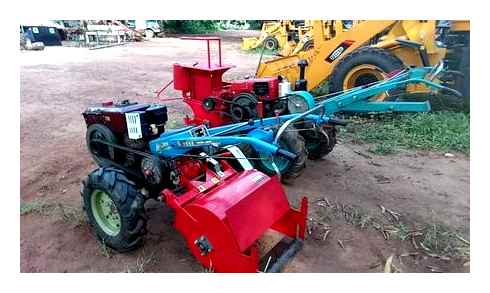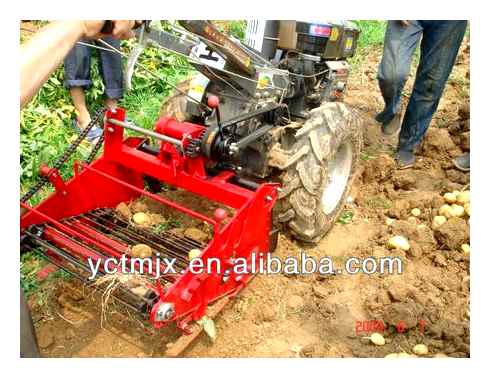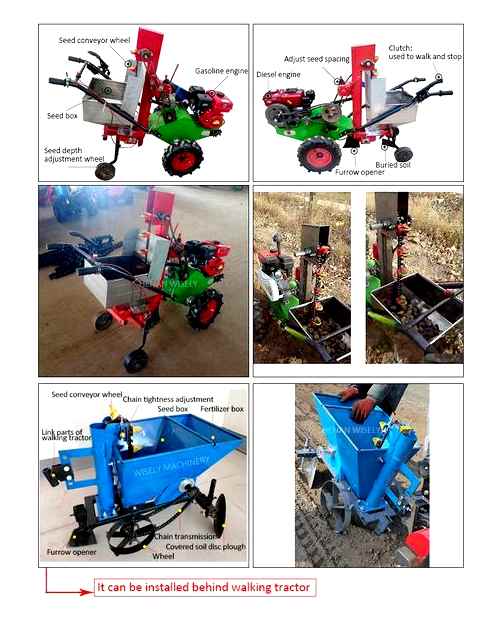Features of designs and types
Before you make a potato tiller for a power tiller with your own hands, you need to study the device, design features and prepare the necessary tools and materials for work. The principle of operation for all models is the same: the teeth of the mechanism plunge into the ground and rake the ground lump together with the root crops. The harvest can be gathered into the hopper or remain on the bed. This will depend on the design decision of the model. There are potato diggers:
Potato harvester
Experienced craftsmen show engineering ingenuity and create their own multifunctional units, which are used for planting root crops, and for hilling and harvesting.
The optimum thickness of metal
The hinged structure is assembled from metal parts. The thickness of the sheet steel should be selected taking into account the anticipated load: the more it will be, the thicker the material should be, too. Specialists recommend using sheets of at least 8 mm thickness.
Wheels for the digger
The design is equipped with movable wheels. When making diggers in the home workshop, they can be borrowed from an old garden wheelbarrow. Wide tires will make it easier to move around the beds. The best option is equipped with an axle. Pillars are attached to the axle, in which locking holes are made.
Alternatively, you can use metal ones. They make the construction heavier, which improves the performance of the frame on hard soils. Rubber ones will move worse on wet ground, rubber ones, but with tractor tread, will perform better in such a situation.
Ways of connecting
All the elements of the unit are connected by contact welding (electro- or gas), as well as with the help of classical fasteners (bolts, nuts). And the advantage of the bolt connection is that if necessary, the unit can be disassembled and reassembled.
Selection and operation of potato harvesters for power tillers
Owners of land plots rather willingly use mechanized helpers for tilling the land and harvesting. Until a few years ago, potatoes were only harvested manually, with special devices found only in large agricultural state corporations. These days, potato diggers are available to even the smallest farmer.
Making a self-made potato harvester for your power tiller with your own hands
For people who live in rural areas, the autumn harvest of potatoes is still a time-consuming activity. Of course, today, few people already do this kind of work by hand, with a shovel. Many people buy a variety of mechanical devices for this purpose, and some, so-called “dabblers”, make various devices with their own hands to save themselves and their loved ones from hard work. The potato harvester, which functions with the help of a power tiller of any modification, whether it is the beloved “Neva” model or a device from another manufacturer, is in particular demand among rural toilers. The main thing here is to have a clear idea of what a homemade potato digger is, and be able to create drawings according to the necessary calculations.
How to make a homemade device with their own hands
Even a beginner can make a potato digger for a power tiller with his own hands. The manufacture of the machine does not require significant financial expenses. The machine is simple, so for its repair and maintenance it is not necessary to involve professionals.
The device for digging potatoes is made of bent metal sheet and rods. Parts are welded and fastened to the body. single-axle tractor moves, tines rake the potatoes, and soil spills between the bars.

Making a drawing for a potato digger with their own hands, the size and type of construction are chosen based on the width of the row spacing and planting depth.
Needed tools and materials
a single-axle tractor is equipped with a self-made mounted potato harvester, if the area of the plot is measured in hundreds of hectares, not tens of hectares. On an industrial scale, it is advisable to harvest using a purchased device.
It is not difficult to make a potato digger with your own hands
Materials, tools and components of the construction:
- steel or iron bars (armature);
- channel rail;
- angle;
- steel with a thickness of 5-8 mm;
- laser level or angle;
- plates for fasteners;
- nuts, bolts;
- drill, engraver;
- welding machine;
- angle grinder;
- adjusting rod;
- suspension system;
- frame;
- grousers (wheels).
It is not necessary to buy all the parts. it is not difficult to make a potato digger for a power tiller with your own hands from those that have been in use.
Use rectangular or square tubes to make the base
Step by step assembly and installation process
The peculiarity of our country’s climate is that during the harvesting of potatoes the soil is always wet. The simple digger will not help here. a more effective device is needed. Assembly is carried out in a certain sequence.
The frame
The basis is made of a pipe of rectangular or square cross-section with sides of 4 cm or more. The support beams are made of a 4-meter billet. It is cut into 80 and 120 cm long pieces, from which a rectangular frame is welded. The corners are connected by gas or electric welding.
Arms and their fasteners
Crosspieces are welded to the frame, but not in the middle of the sides, but at a distance of a quarter of the length from the edge. On the back side of the frame, support tubes are welded vertically and the base for the axle is attached to them.
Nuts and bolts are used for mounting, and the holes are made with a drill or graver. The wheels are mounted on the axle.
Vertical props
In total, 3 vertical struts are made on each side of the frame. The first one is 50 cm long, at a distance of 5 cm from the edge of the rectangle. the second one is 40 cm. and is separated from the first one by 40 cm. The third leg is 40 cm from the second leg, 30 cm long. The result is a descending ladder.
In order to prevent the machine from collapsing under the heavy loads, it needs stiffening for the uprights
Stiffening
The uprights are stiffened with a 0.5 mm thick strip of metal. At the bottom, the elements are joined together at a 45 degree angle. The stiffness of the uprights is needed, so that the machine does not collapse under the strongest of loads.
The stalk, or ralo
The frame is made of a 0.3 mm thick sheet of metal. According to the drawing, the blades are cut out and the plow is connected to them by welding. To make the blades grip the ground better, you need to give them a convex shape.
Making a sloping board
The board, on which the tubers will roll as they are cleared of the soil, is also part of the machine’s construction. In order not to make the construction heavier, the gantry is made of thin metal rods. A rebar with a length of 1.2 m and a diameter of 1 cm would be fine. The pieces are welded 4-5 cm apart.
Adjustment rods
Suspension bars are not a required part, but they make it easier to use the potato harvester on wet and hard ground. Alternatively, the adjustable structure is attached to a separate frame, and this is connected to the main frame. Fasteners are tightened with bolts and nuts.
The ease of movement along the rows depends on the width of the tires
Support wheels
The wheels are an obligatory part of the potato harvester. The width of the tires determines the ease of driving in rows: narrow wheels sink into the ground when driving, especially if it is wet. Tires from a garden wheelbarrow or other unnecessary device will be suitable.
Any single-axle tractor with a potato harvester has its own features, including the rumble design.
The creation of a vibrating mechanism will require the following tools:
Also fasteners will be necessary.
Important! All parts must be of high quality. Otherwise, the harvesting of potatoes with a power tiller will be of poor quality, and the mechanism will not last long.
As with any variant, initially a frame is created, which will carry the entire structure and elements.
On the frame is already carried out attachment of additional and basic elements. Features:
- The whole process of creation is regulated by the drawing with all calculations;
- fasteners of any type must be prepared in advance;
- any deviation from the design leads to incorrect or incomplete work;
- After the creation of the device it is necessary to make adjustments.
An important point is that the screen mechanism may have different features, depending on the requirements. For example, there is a double eccentric vibrating shovel.
In homemade construction, the mechanism may have significant differences from the conveyor version. Everything depends only on the model of the motoblock, as well as on the capabilities of the creator of the self-made mechanism.
You will need welding to build the screen designs
Model Poltavchanka
Poltavchanka also refers to vibrating screen diggers. Its design allows to work with all power tillers. To do this, the pulley of the machine is installed on both the left and the right side with the necessary displacement of all work items. With the help of a roller adapter, the unit can be mounted on power tillers with rear PTO.
Potato digger Poltavchanka is used when working with soils of medium severity.
The machine has the following technical specifications:
- dimensions 950x790x800 mm;
- weight 34 kg;
- 2 km/h speed;
- the digging depth is 25 cm;
- working width of 40 cm;
- productive capacity 0.25 ha/h.
The potato harvester for power tillers is equipped with a pin and a belt.
Small size and weight allow you to work with the machine in the field and transport it to the place of operation.
Necessary tools
The following materials and tools are required for the work:
Good steel is needed for the manufacture of plowshares. it must be quite thick (at least 4 mm). The construction has a welded frame, hangers, pull rods, which will allow to adjust the dynamic elements. wheels and hooks.
It is not very difficult to make the machine yourself. Such a potato harvester can really be used on any, even very heavy soils.
Self-trained craftsmen design potato diggers of two varieties.
It is a bit more difficult to create conveyor and drum units, because their design will be a bit more complicated, but technically it is quite feasible to create such units.
If you have to harvest large areas, you should pay attention to the screen or transporter potato harvester. For a cottage or garden plot of 10 acres may be quite suitable and fan digger.

The disadvantage of all potato diggers is that they don’t “take out” the whole crop. Tubers that grow away from the cultivated strip, do not fall into the field of action of the plow.
Basic types of potato diggers
Any potato digger is designed for loosening the soil under the potato bushes and transporting tubers with the help of tines to the surface, where they can be quickly removed by hand.
There are several types of potato diggers for power tillers, which you can make yourself for digging crops on the homestead plot:
- simple (lancet, single row, fan type). by the type of plow;
- vibrating, or screen ones;
- Transporter type (they are also single-row);
- universal.
A simple potato digger for a power tiller is a plough that has guide rods (arrows) welded to it. When the plough digs into the ground, the soil, together with the tubers, rises along the rods. At the same time, the excess soil is sifted out, and the tubers remain on the soil surface. Such potato digger can be mounted on a mini-tractor or any single-axle tractor, such as Neva, MTZ, Salyut.
A vibrating (vibration-crushing) potato harvester is a construction where a ploughshare and one or more screen gratings are used, which are supported by wheels. The blade loosens the soil that falls onto the screen together with potato tops and tubers. In the process of movement, the soil is sifted and the potato tubers, separated from the haulm, are poured onto the surface of the cultivated row.
Transporter potato digger for power tiller is a more complex version, where the soil from the ploughshare falls on the moving conveyor belt, equipped with a hitching device. This allows the potatoes to be held on the belt, while clearing the soil at the same time. This kind of digger is more practical than a vibrating one, but its use is appropriate only for heavy soils.
Universal potato diggers combine several of the above types of devices. here it all depends on what functions you want to give your potato digger, made specifically for your plot.
Many people acquire for this purpose various kinds of mechanical inventions, and some craftsmen, so-called hobbyists, only in joy to make their own potato digger, to save themselves and their loved ones from hard work. Particularly popular among agricultural workers received a potato digger, which operates on the basis of a power tiller of any variation, whether it’s a favorite model of all the Neva, or a mechanical device from another manufacturer. In this case, the main thing is to have a clear understanding of the design features of the homemade potato digger and the ability to create drawings.
A necessary clarification: this mechanical device is attached to the power tiller to do the work. Such a unit, made his own hands, can handle the land around the house, and in the field. The main purpose of the potato puller is to separate potato tubers from the soil and place them on the ground. Such a machine is easy to operate, and it also has a fairly simple design. So making one yourself is usually not too hard. The main thing is that this mechanical attachment fits on any model of power tiller.
Many will argue, why waste time and effort, if such a miracle of technology can be bought without problems at any point of sale of agricultural mechanisms and devices. This point of view has a right to exist, and many people do.
However, any experienced gardener knows the main advantages of a home-made digger:
- Such a mechanism is much more practical, because it is designed for a particular soil characteristics of a particular area, as well as the strength of a particular person. the future happy owner.
- The cost of a self-made device is much lower than that of a ready-made product, which is sold in specialized stores.
Before starting the creative design processes of constructing a potato digger, remember: it is adapted to function on soils with medium and low density. In order to build a machine designed to work on heavy soils, you need a deep knowledge of mechanics and, of course, physics.
There are the following varieties of diggers for potatoes:

- The machine is of the screen or vibrating type. it mainly consists of a ploughshare and a vibrating screen. Functions such a type of potato digger on the basis of a power tiller is quite primitive. Ploughshare undermines the soil together with the tuber. Then the stationary conveyor grate joins the work, leaving the tubers on its surface, and as if through a sieve, sifting the ground. This model is considered one of the most effective in the work, but rather complicated in terms of manufacturing.
- Transporter type. it is able to work with ease, for example, on the basis of such a motor-block as the Neva. The device of the transporter digger includes a ploughshare and a moving transporter, which has a special hitch to support the tubers on the platform and clear the soil. The transporter unit for digging potatoes is more practical compared to the vibrating type of potato digger. However, the use of this type of device on soils with a light density criterion is impractical.
- Rifle unit. by design it is the simplest mechanism that can be easily attached to any model of mini-tractor, say, the same Neva. It does not contain any movable parts; the soil and tubers are cut with a knife. Then the cuttings fall on special rods, where the earth is poured back, and the clean fruits are placed on the surface of the soil. This type of digger is more effective on the soil with a low degree of density, where the use of other varieties of devices is ineffective.
Before starting the construction, first of all, it is necessary to know exactly the density of the soil on which the operation is planned. Keep in mind that where a conveyor mechanism can function perfectly, it will be difficult to work with a design of lancet type. In a small farm, it will be most convenient to harvest potatoes with a device of relatively small size. This type of digger should be comfortable during use and be easily mounted on a single-axle tractor.